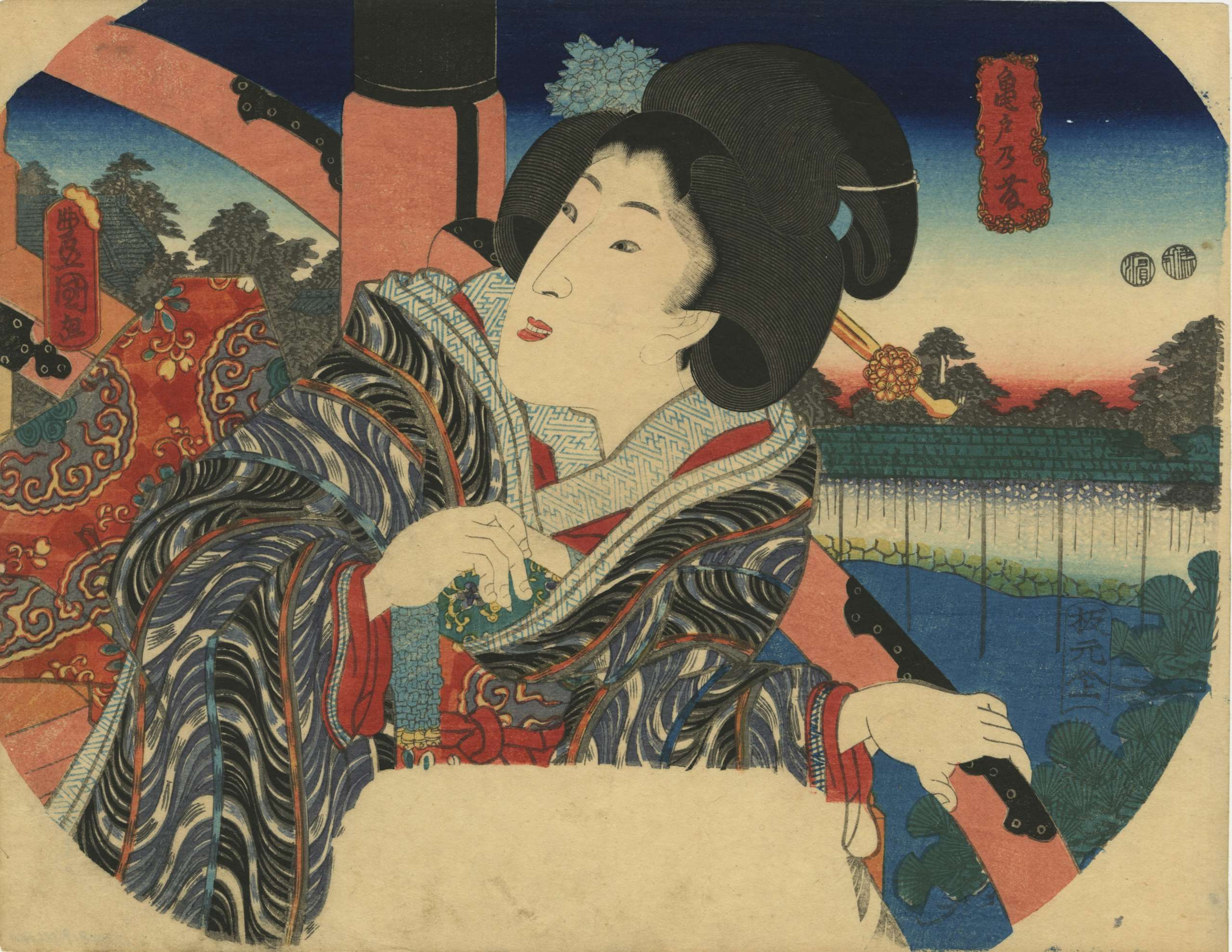





A young woman adjusting her hairpins in the light of a paper lantern. Series: Arigataki miyo no kage-e (Shadow Pictures of an Auspicious Age). There are five known prints, half-length portraits of beauties, in this series, designed by Kunisada in ca. 1844. Another print from the series in this collection: SVJP-0309.2020: A young woman reading a book in the light of a lamp.
Signed: Kōchōrō Toyokuni ga (香蝶楼豊国画). Publisher: Maruya Kiyojiro.
Size: Vertical Ōban (37.5 x 25.4 cm). Utagawa (歌川) SOLD
 Ref.: (1) [LIB-1197.2016] Arendie and Henk Herwig. Heroes of the kabuki stage: an introduction to kabuki with retellings of famous plays, illustrated by woodblock prints. — Amsterdam: Hotei Publishing, 2004; pp. 243-249.
Ref.: (1) [LIB-1197.2016] Arendie and Henk Herwig. Heroes of the kabuki stage: an introduction to kabuki with retellings of famous plays, illustrated by woodblock prints. — Amsterdam: Hotei Publishing, 2004; pp. 243-249.





 Other prints from the same series in this collection:
SVJP-0343.2021 — Tamagiku:
Other prints from the same series in this collection:
SVJP-0343.2021 — Tamagiku:
 SVJP-0400.2023 — Saiko:
SVJP-0400.2023 — Saiko:
 Note: Special thanks to Horst Graebner, who helped decipher and understand the meaning.
Note: Special thanks to Horst Graebner, who helped decipher and understand the meaning.



A young woman adjusting her hairpin on a balcony during the Tanabata festival, as inscribed on the white folding fan: [七夕] (Tanabata).
Inscription on the blue book (print title): Early autumn [はつ秋や] (hatsu akiya), inscription on the purple book (series title): Short love songs, second volume [端唄の意 二編] (Hauta no kokoro nihen). According to Marks (2010), Hauta no kokoro nihen series of fan prints was published by Ibaya in 1858 (p. 267|P6871).
The series refers to love songs of a certain type popular in late Edo. They were performed with the accompaniment of a shamisen, “Seven herbs of autumn, the song of the insects is not heard; the bodies of lightning bugs are burnt, and the precious writings of love are getting thinner like the song of the insects as I am waiting for you. So, on an early autumn evening, I spot the glitter of a lightning bug that lingered among the autumn grasses, and while listening to the pine cricket, I am singing with my heart troubled by love". [Tokyo National Museum; translation provided by Elena Varshavsky].Tanabata [たなばた] or [七夕] – meaning "Evening of the seventh", also known as the Star Festival [星祭] (Hoshi matsuri) – is a Japanese festival originating from the Chinese Qixi Festival. One popular Tanabata custom is to write one's wishes on a piece of paper and hang that piece of paper on a specially erected bamboo tree, in the hope that the wishes become true.



 As noted by Horst Graebner, the gentleman also resembles the character on another Kunisada's actor print, published in 1852 (Waseda University Cultural Resources Database № 114-0232):
As noted by Horst Graebner, the gentleman also resembles the character on another Kunisada's actor print, published in 1852 (Waseda University Cultural Resources Database № 114-0232):




A man with a shaved head (a monk), holding a paper lantern and an umbrella, walks with a young woman (a geisha) in the rain.
SIGNED: Gototei Kunisada ga [五渡亭国貞画]
Censor's seals: kiwame, futakata.
Blockcutter's mark: Seizô tô [改印:極、貳方]
MFA ACCESSION NUMBER 11.15150; MFA dating: about 1815–21 (Bunka 12–Bunsei 4);
Size: Vertical Ōban (382 x 260 mm). SOLD

 SVJP-0341.2021 |
 |
Kabuki actors Onoe Kikugorō III and Iwai Kumesaburo II. Year: c. 1832; Publisher: No seal; Signed: Kōchōrō Kunisada ga From Kunisada Project. |
 |
Kabuki actors Bandō Minosuke II and Iwai Shijaku I. Year: c. 1832; Publisher: No seal; Signed: Kōchōrō Kunisada ga From Kunisada Project. |

 SVJP-0335.2021 |